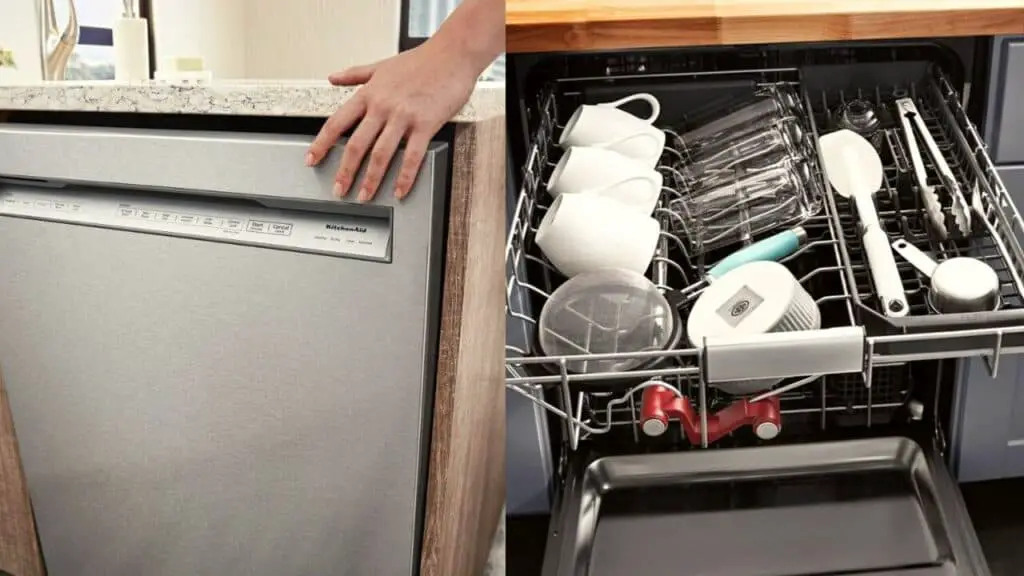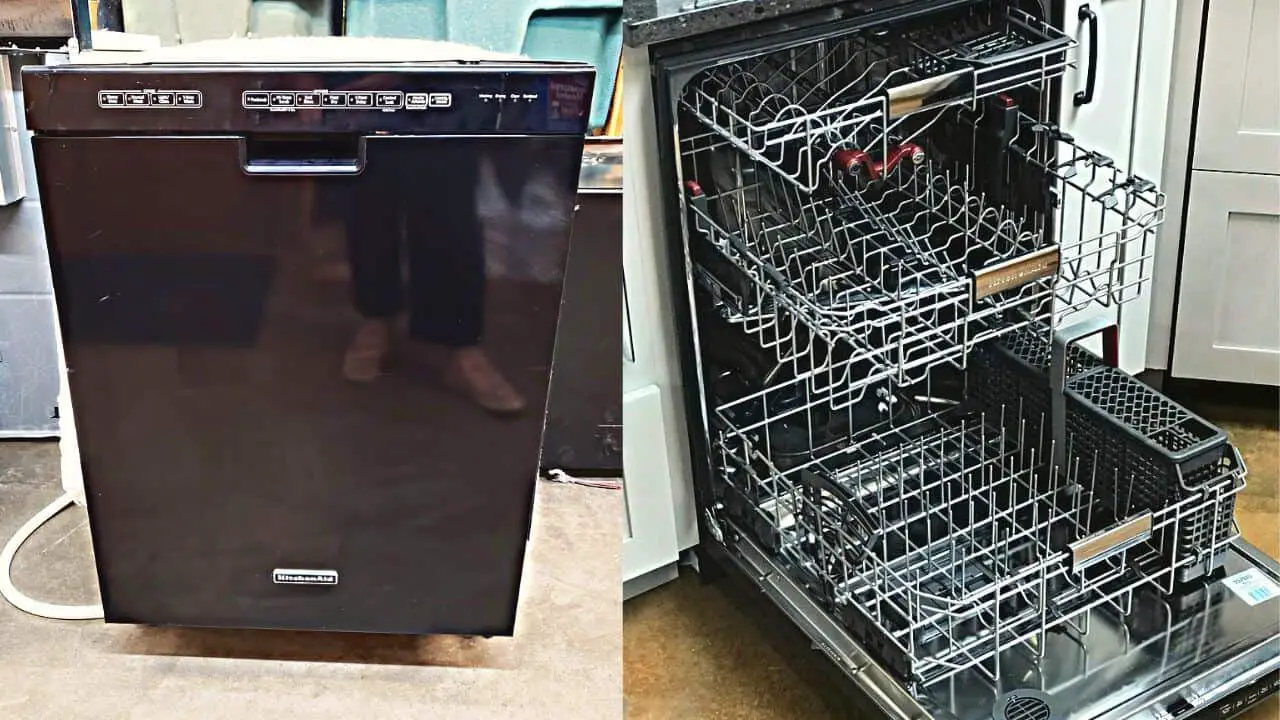Last Updated on May 19, 2023 by River Tree Farms
KitchenAid dishwasher not cleaning top rack is a common problem among thousands of owners of this trendy brand. If you are one of them, you might want to read on as I’m going to tell you about this issue and how to solve it at home.
The first thing you should know is that the KitchenAid dishwasher not cleaning the top rack has nothing to do with the quality of these products by KitchenAid – quite the contrary is the lack of reasonable maintenance and routine care by you-the KitchenAid dishwasher user.
Have you been surprised by your KitchenAid dishwasher not cleaning the top rack? It could be because the spray arms are not working correctly (either a damaged spray arm zeal or clogged spray arm nozzle, insufficient water inlet, and in some cases, failure of Kitchen aid heating element.
The result? Nothing but a dirty kitchen. That’s why I thought it would be nice to write an article on how to troubleshoot a non-cleaning Kitchen aid dishwasher top rack to help people fix their appliances instead of throwing them out and buying new ones.
Looking deeper:
Why is the KitchenAid dishwasher not cleaning the top rack?

Quickly let me explain how a kitchen aid dishwasher works.
The water inlet valve allows the water into the dishwasher, which fills to a certain level. The water is automatically pre-heating by the heating elements, and then it gradually heats up to the boiling point. The detergent dispenses, and the spray arms spin under pressure flashing the water onto your dishes.
If any of these processes are not working well on either of the racks, then the dishes will remain dirty after a wash cycle.
The kitchen aid dishwasher is not cleaning because of the listed possible causes:
1. Top Rack Spray Arm Problems
Up to 80 % reason for the dishes not getting clean at the top rack layer of the kitchen aid dishwasher will have to be associated with the spray arms problems, including:
2. Faulty dishwasher spray arm seal
It is an essential part of the spray arm and the dishwasher. It is responsible for sealing any water leakage through the fittings.
When the spray arm seal is defective, The water leakages will give the spray arm less pressure due to insufficient water. The low-pressure water will not clean the dishes properly.
3. Clogged Spray arm nozzle
Another problem is when the spray arm nozzle gets clogged with dirt, food particles, or mineral deposits. The nozzles are spread out through the spray arms, so please physically check for the clogs.
There must be a clean top sprayer in the dishwasher for the water to efficiently reach the dishes and clean well.
4. Dishwasher Top Rack Not Spinning
If the top rack spray arms have all sorts of dirt, build, and debris, they cannot spin freely. Another thing that will cause the spray arm not to turn in the dishwasher is the overstacking of dishes or the wrong arrangement, especially in the lower rack. You must check what prevents your kitchen aid dishwasher from spinning correctly and clear the way.
5. Faulty Circulation Pump
KitchenAid spray arms spin using the circulation pump power. The pump quickly gets faulty, mainly if you use hard water.
The hard water is rich in mineral deposits, and with time, these minerals build up and clog the pump with scale-like rocks of minerals.
On the other hand, the pump can have no deposits and still get faulty.
The spray arms will not do their work with a non-functional circulation pump. If the abovementioned does not apply, consider KitchenAid spray arm replacement.
6. Insufficient Water Issues
It is sure for the KitchenAid dishwasher not to clean the top rack when there is not enough water in the dishwasher. Insufficient water will not cause the high pressure that cleans the dishes well on the top shelf.
What causes insufficient water in the Kitchen Aid dishwasher?
7. Faulty water inlet valve
If the valve does not let sufficient water inside the dishwasher, the dishes, especially on the top rack, will not be clean. The valve can just have some clogging as well, or the whole thing would require replacement.
8. Clogged filters
The filters are located at the bottom from where the water oozes out to provide clean water to the dishwasher. These filters get clogged by mineral deposits or ordinary water particles. Therefore, the water will not flow sufficiently into the dishwasher for easy cleaning.
Any problem with water will first affect the top rack before it affects the lower shelf. Why? The top rack needs more pressure to get the water to the top and later spin to clean the dishes.
9. Heating element problems
Though this is not a common problem for the top rack, it is good to mention both frames since cold water will not clean your dishes.
The Kitchen aid heating element sometimes gets faulty or the motor power stops functioning. Then the water will not heat up to clean the dishes properly.
10. No detergent
If the soap dispenser does not let the detergent into the top rack of the dishwasher, the dishes will remain dirty. The detergent aids in removing grease together with the warm water, and if either misses in the equation, you will get a Kitchenaid dishwasher not cleaning.
Having discussed the possible causes of your kitchen Aid not cleaning, let us have a summary of the solution.
KitchenAid dishwasher is not cleaning the top rack, Exact Solutions Here:
- Replace the spray arm seal if it has damages causing the leakage.
- Clean the spray arm nozzles by pulling the visible debris using a toothpick or a toothbrush.
- Remove all the obstacles that will make the dishwasher top rack not spin.
- Clean and remove clogs from the circulation pump or replace them if they are not functioning properly.
- Refer to the Kitchen Aid user manual on properly stacking the dishes for proper cleaning. Do not overstack dishes, either.
- Run a descaling solution in the appliance to eliminate the mineral deposits clogging different dishwasher parts. Always top up the rinse aid.
- Replace a faulty water valve.
- Clean clogged filters, or if so worn out, replace them with new filters.
- Replace damaged heating elements and motors.
- Always use phosphate-based detergents, and make sure the dispenser is always with tablets.
Please note: Make it a habit to clean your KitchenAid dishwasher often. Remove all the debris and any clogs that might affect how the dishwasher cleans.
Frequently Asked Questions (FAQs)
How much does a kitchen aid spray arm cost?
A spray arm will cost approximately $ 35. Removing and replacing a spray arm is straightforward, but you can still seek professional help if you do not feel like you are up to the task.
Why does my KitchenAid dishwasher leave a white residue?
It leaves white residues as a result of phosphate residues. The best dishwasher detergents contain phosphate, which breaks down by acting on the food particles and grease. If the dishes are clean and the wash cycle runs with the detergents dispensation, utensils remain with a white residue.
How often should I clean my KitchenAid dishwasher?
It would help if you cleaned your dishwasher every month using a quality cleaner targeting all the sensible parts prone to clogging and skunks. It would help if you also run a solution to remove the mineral deposits before the final thorough cleaning.
Related Post:
Conclusion
It is for sure that a dishwasher is a huge help when it comes to cleaning your dishes. It takes all the hard work of scrubbing by using some heating element to get to those hard-to-reach places where most other machines fail. However, there are times when your dishwasher won’t clean the top rack properly or not at all!
That is why I came in with some ways that you can troubleshoot and fix this problem on your own.
However, if none of these solutions work, you may need to call a professional for help.
Here are other interesting topics you can check out:

